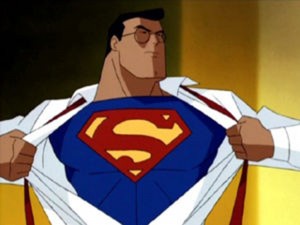(DC COMICS CLASSIC COLLECTIONS/WARNER HOME VIDEO; 2005-2006; Original Television Series, 1996-2000)
With MAN OF STEEL an unqualified hit, I thought it was time to examine one of my favorite non-comic book versions of the Last Son of Krypton. The three volume DVD collection of SUPERMAN – THE ANIMATED SERIES is once again gracing the shelves of your local box store and readily available for a sweet lower price (there also exists a SUPERMAN – THE COMPLETE ANIMATED SERIES, which is exactly what it sounds like. It just isn’t available at the box Mart in my neighborhood). So, we concern ourselves with the three separate volumes: all 54 episodes of the now-classic cartoon are here, as well as plenty of bonus extras that delve into the characters and the creators.
For the 3 volumes of SUPERMAN – THE ANIMATED SERIES, rather than giving us a more traditional season-by-season release, Volume 1 offers the first season and the first five episodes of Season 2 (which is 28 episodes, more than double the Season 1 total). The second volume features the next 18 episodes of Season 2, while Volume 3 features the final five episodes (including two 2-part arcs), all 10 Season 3 episodes and the last 3 episodes, which make up the entirety of the fourth and final season. Why only three episodes in that last season? Well, producers Bruce Timm and Paul Dini had intended a full season story arc initiated with the two-parter “Legacy.” The WB network (which aired this series, the BATMAN animated show, as well as the BATMAN BEYOND series), however, wanted the team to focus their creative energies on the newer BATMAN BEYOND. Interestingly enough, BATMAN BEYOND was also put on hold two years later to allow Timm and Dini to work on the new JUSTICE LEAGUE series, allowing everything to come full circle, as that series utilized elements and plot threads from all previous DC animated universe shows (including STATIC SHOCK). But, for now… let’s go back to the beginning.

Debuting in September, 1996, this new, animated SUPERMAN took its cues from BATMAN – THE ANIMATED SERIES, with a very stylized approach to the artwork and with stories that stuck very close to the source materials. That made comic book geeks extremely happy! The production team, headed up by Bruce Timm, gave us fairly traditional takes on Martha, Jonathan and Clark Kent, Jor-El and Lara, Lois Lane, Perry White and the major villains (Brainiac, Metallo and – of course – Lex Luthor). There’s also an updated, hipper Jimmy Olsen, as well as retro-versions of a few second-tier baddies like the fifth-dimensional imp, Mister Mxyzptlk and the Toyman. Throw in the nearly forgotten Jim Shooter/Al Plastino creation, Parasite, add a healthy contingent from Jack Kirby’s Fourth World (New Gods, Darkseid, Granny Goodness) and some new blood, in the form of Livewire, and you’ve got a party. Heck, even Bruce Wayne, Tim Drake, Arthur Curry, the Flash, the Joker and Harley Quinn show up in various episodes.

As with the BATMAN series, this show works on a myriad of levels, one of the most important being the use of great actors. From the lead characters (Tim Daly as Superman/Clark Kent, Dana Delaney as Lois Lane) to secondary characters like the Kents (Mike Farrell and Shelley Fabares) and the wickedly evil Granny Goodness (played to the hilt by – are you ready for this? – Ed Asner!), the cast of SUPERMAN – THE ANIMATED SERIES reads like a producer’s rolo-dex of some of the most recognizable and well-loved voices in Hollywood. In fact, most of the actors are so spot on that they were asked along for the ride when Timm and company launched JUSTICE LEAGUE (and its later incarnation, JUSTICE LEAGUE UNLIMITED). I believe the only actor who would have had overlapping roles in both this and the JL/JLU series not to appear in the latter show would be Supes himself, Tim Daly, who was already under contract to star in another (live action) series. That these talented individuals made themselves available to reprise their roles (often quite small, especially in the JUSTICE LEAGUE shows) speaks volumes about production standards and the top-notch, knowledgeable writing staff.
Every good super-hero story should start with an awesome origin story and, Superman’s is the one that every creative team since 1938 have been using as a template, to varying degrees of success. As it should, this series begins with an awesome three part story called “The Last Son of Krypton,” which is heavy on the Kryptonian lead up to Kal-El’s arrival on Earth, offering new insights into the societal hierarchy of the doomed planet, as well as an intimate look at the lives of Superman’s birth parents, Lara and Jor-El. A major divergence with the comics is the revelation that the evil mind-construct Brainiac started out as the “brains” behind Kryptonian science, culture and politics. The seemingly benevolent computer is seen as the dispassionate destroyer of the planet, preferring to collect all pertinent information on the planet and its inhabitants rather than offering a solution to its ultimate demise. In short, the ultra-rational Brainiac puts knowledge (and his own survival, as the conservator of the history and knowledge of Krypton) above life. While the comic book version went through various incarnations and minor adjustments in his origin since his debut 45 years ago, this version just seems right. I am rather surprised that DC didn’t adopt this storyline when they deconstructed their entire universe with the New 52 (of which, the less said here, the better). I mean, there is precedent: Harley Quinn, arguably one of DC’s most popular villains, made her first appearance in the BATMAN animated show. A later episode of SUPERMAN introduced Livewire, who went on to appear in various DC titles, as both villain and reformed hero.
Other stellar episodes from that first season (a total of 13 episodes, airing during1996-1997) include “Feeding Time,” which introduces Parasite, a little used character from the comics, turning him into a force to be reckoned with in the Superman animated universe; a two-part story called “The Main Man,” guest-starring – DUH! – Lobo, the loud-mouthed galactic bounty hunter; and “Tools of the Trade,” in which recurring gangster boss Bruno Mannheim signs a deal with the devil… Jack Kirby’s ultimate DC creation, the evil megalomaniac Darkseid (deliciously voiced by Michael Ironside), who from this point forward is the focal point of the series as Superman’s main nemesis. Darkseid casts a huge shadow over the DC animated universe, as the ultimate climax of the massive storyline isn’t realized until much later, in the final episode of the JUSTICE LEAGUE UNLIMITED series.

Standouts from Season 2 (probably THE standout season of the entire series) include “The Prometheon,” in which a giant alien android is unwittingly loosed by Superman, to wreak havoc, Godzilla-style on high-tension wires and nuclear generators across the world. The Flash shows up in “Speed Demons,” featuring a plot right out of the comics, with Supes and Wally racing around the planet for charity. When the Weather Wizard decides to hold the climate hostage to get a little respect, hilarity and a tag-team beatdown ensues. The aforementioned “Livewire” is born when a shock jock with a mad on for the Man of Steel is hit by lightning before Superman can save her. Obviously, the fact that he showed up late to the electrocution meant that Kal was to blame and Livewire would become a constant thorn in his side throughout the series (and beyond, in the final season of JLU). Two recurring characters from the comics debuted in this second season: Bizarro (a failed attempt by Lex Luthor and others to clone Superman) and Mister Mxyzptlk, the latter splendidly voiced by the abrasive comedian, Gilbert Gottfried. Often used in the comic books as a comedic foil for Superman, Bizarro’s appearances here are more poignant than funny, as he – like Kal-El before him – seeks his place in a world (and universe) that mocks and shuns him.
As you can see, guest-stars and old school villains abound in this season, including the Dark Knight and his most crazed protagonists, the Joker and Harley Quinn, who all show up in a three-part episode called – what else? – “World’s Finest.” Doctor Fate is called upon for mystical assistance in “The Hand of Fate.” John Henry Irons becomes the hero Steel in “Prototype” and returns in “Heavy Metal” to help Superman against Metallo. The final four episodes prominently feature Jack Kirby’s Fourth World creations, including Granny Goodness and Darkseid. The last two episodes are called “Little Girl Lost” and serve as an introduction to Kal’s cousin Kara, better known as Supergirl, as she and Jimmy Olsen infiltrate a teen gang who are actually being controlled by Darkseid’s evil minion, Granny Goodness.

The most stunning piece of writing and animation comes with episodes 25 and 26, a two-parter called “Apokolips.” With Superman beaten and captured by Darkseid and his armies, the people of Metropolis, led by Detective Dan Turpin (whose character and appearance are based on Jack Kirby himself), rise up and refuse to surrender. As Turpin turns the weapons of Apokolips on Darkseid and uses one to free Superman, Darkseid uses his powers to make an example out of the policeman, vaporizing him with his gaze. Now free, the Man of Steel begins crushing both weapons and parademons alike, forcing Darkseid to retreat, vowing vengeance. The final funeral scenes are some of the best television moments ever. Yeah… I just said that!

Season 3 is not as dramatic as the previous… how could it be? There are, however, a couple of episodes that are – if nothing else – pure and simple super-hero/comic book fun. Robin (the Tim Drake version) appears in “Knight Time,” covering for a certain Darknight Detective. Once Clark Kent realizes that the Batman has gone missing, he swoops in to lend a hand, much to the chagrin of the Dynamic Duo’s junior partner. The Legion of Super-Heroes show up in “New Kids In Town,” Kyle Raynor makes a rare DCAU appearance as Green Lantern in “In Brightest Day” and Aquaman is captured by Luthor in “A Fish Story.” “Little Big Head Man” finds the fifth dimension imp, Mxyzptlk, tricking a contented Bizarro into returning to Earth to confound Superman with a double whammy of lunacy.
Superman battles one of Batman’s most dangerous foes, as Ra’s Al Ghul brings his Society of Shadows to Metropolis in “The Demon Reborn,” the first episode of the unfortunately aborted fourth season. Darkseid returns for the series two-part finale, “Lagacy.” The Lord of Apokolips brainwashes Kal-El into believing that he was raised on Apokolips as Darkseid’s son. With Superman reappearing on Earth after a long absence, the citizens of Metropolis are appalled at his destructive actions. By the time he regains control of his own mind, the populace of his adoptive planet are in total fear of the Man of Steel and, as a result, have turned against him. Had the series not ended, this story would have arced across the season, as Superman worked to regain the trust of the people of Earth. Thankfully, this thread is picked up later in JUSTICE LEAGUE and JUSTICE LEAGUE UNLIMITED.

There is so much neat stuff going on in this series (and, in fact, all of the other DCAU series) that any comic book geek should find and watch it in any form available (DVD, Blu-Ray, Netflix, whatever). If you find the DVD/Blu-Ray collections (either the three separate volumes or the complete series), buy them, if for no other reason than to have the cool bonus features, including creators’ commentary on several key episodes, lending insight into the series and the characters. It is well worth the investment, especially at these new, cheaper prices.

